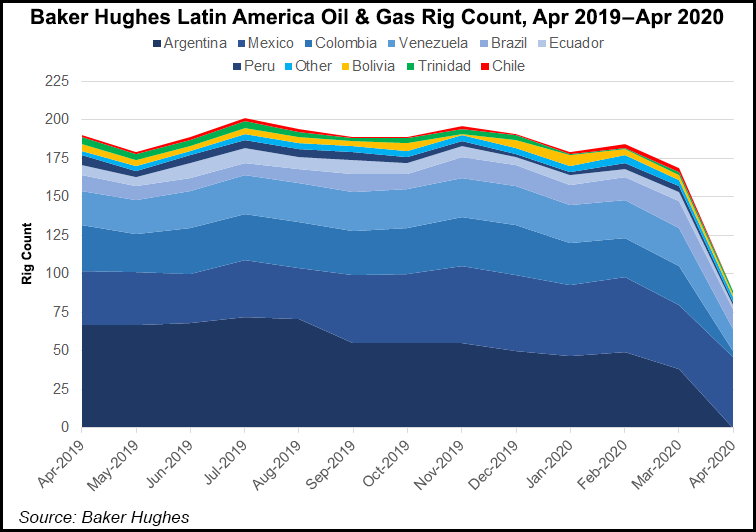NGI The Weekly Gas Market Report | E&P | NGI All News Access
As Mexico Lockdown Eases, Pemex Hit With Alarming Coronavirus Problem
Mexico’s Petróleos Mexicanos’ (Pemex) difficult year has been made harder as workers struggle with a coronavirus outbreak that has hit the state oil company particularly hard.

On Wednesday, the company said 77 employees had died of the coronavirus. A total of 228 Pemex employees and family members, including retirees, have so far lost their lives to the pandemic, whose epicenter has now moved to Latin America.
Outbreaks have reportedly been acute on some offshore oil and gas platforms, which have remained manned through the pandemic, even as much of the rest of the economy, including mining and construction, was shut down to the virus.
Indeed, despite coronavirus restrictions, President Andrés Manuel López Obrador’s administration has bucked the trend of cutting back given the low-price environment and has pushed ahead on plans to grow production.
Mexico actually increased its rig count in April to 46 active rigs, compared to 44 in March and 35 in April 2019.
Mexico’s government in April also threw its backing behind Pemex by agreeing to measures including a fiscal relief decree freeing up $6.5 billion this year.
Executives at Pemex said they have now achieved their goal of stabilizing years of declines in oil production and the company is “on a path of production growth and increasing the crude oil processing levels of our refineries.” They also claimed that production costs at the new priority fields are below $5/bbl.
In the first quarter Pemex liquids production rose 2.7% year/year to 1.76 million b/d, compared with 1.67 million b/d in the first quarter of 2019. Natural gas production also stabilized, averaging 3.74 Bcf/d, up 1.9% from a year earlier. The government aims to hit 2.7 million b/d of crude production by 2024.
The picture is in stark contrast to the rest of Latin America.
Colombia had only four active rigs in April, compared to 25 in March, while Brazil shed four, to 13 rigs in April. Venezuela also saw a sharp drop in the rig count, with 14 rigs active in April, down from 25 in March, while Argentina’s rigs were completely idle in April.
Some operators, including BP plc and Royal Dutch Shell plc, have reported coronavirus cases on platforms in the Gulf of Mexico, but no fatalities have been reported.
“In some ways the fact that Pemex is seeing these high mortality rates is not surprising because Pemex is not being run well and hasn’t been run well for a long time,” the Wilson Center’s Duncan Wood told NGI’s Mexico GPI. “They have problems in terms of administration and procedures.
“It is also perhaps not a surprise because you have a government which is committed to raising oil production from Pemex any way they can, and throwing in huge amounts of money and investment into existing oil fields.”
Pemex has reduced the number of workers on offshore rigs and claimed its prevention strategy has “helped contain the spread of contagion among workers.” It cited the “Pemex Más Cerca de Ti” program, a system of remote healthcare to help those who are sick or showing symptoms of Covid-19.
Wood said the level of outbreak is a sad sign for Pemex, “a government agency that has invested heavily in its employees and has one of the best health services in Mexico,” with Pemex-owned hospitals and doctors.
“Anecdotally, we’ve heard of Pemex workers who are being told that if they don’t go out onto the rigs then they are not going to get paid even if they are sick,” Wood said. “It’s really a betrayal of the responsibility of management and leadership at the company.”
It doesn’t bode well for the heavily indebted oil producer. Moody’s Investors Service in April downgraded its bonds to below investment grade, following on a similar action by Fitch Ratings. Shortly after the downgrade, Pemex announced a stunning $23 billion first quarter loss.
Meanwhile, Mexico’s lockdown is set to ease considerably for the first week of June, with some economic activity deemed as nonessential allowed to resume.
Mexico had 78,023 confirmed cases of the coronavirus on Thursday, with 8,597 fatalities, according to Johns Hopkins University. The government’s Health Ministry said earlier this week that the mortality rate in Mexico was the highest in Latin America.
© 2024 Natural Gas Intelligence. All rights reserved.
ISSN © 2577-9877 | ISSN © 2577-9966 | ISSN © 1532-1266 |
